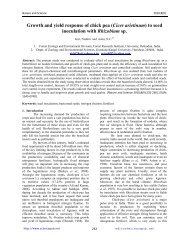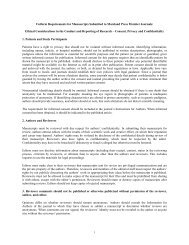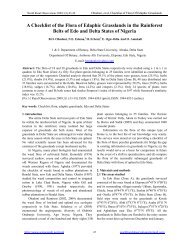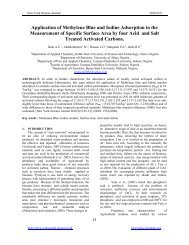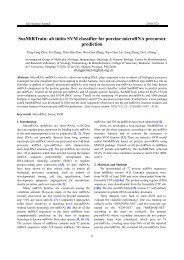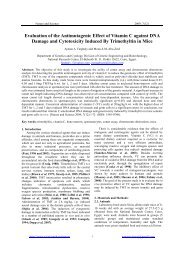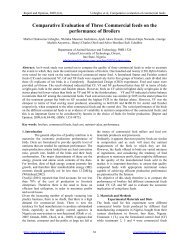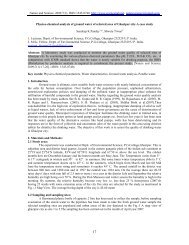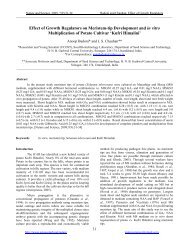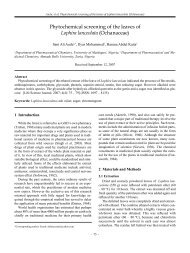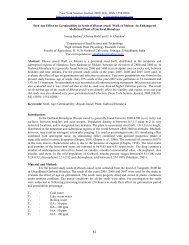Ecological, Social and Commercial Role of Lichens in India with ...
Ecological, Social and Commercial Role of Lichens in India with ...
Ecological, Social and Commercial Role of Lichens in India with ...
Create successful ePaper yourself
Turn your PDF publications into a flip-book with our unique Google optimized e-Paper software.
Acdemia Arena 2010, Supplement 0201<br />
http://www.sciencepub.net<br />
Mounta<strong>in</strong>s <strong>and</strong> hill hold a rich variety <strong>of</strong> ecological systems. Because <strong>of</strong> their vertical<br />
dimension, mounta<strong>in</strong>s create gradient <strong>of</strong> temperature, precipitation, <strong>and</strong> <strong>in</strong>sulation. In Uttarakh<strong>and</strong><br />
n<strong>in</strong>e <strong>of</strong> the thirteen districts comprise the expansion <strong>of</strong> lesser Himalayas. But <strong>with</strong> the rapid<br />
modernization <strong>and</strong> <strong>in</strong>creas<strong>in</strong>g anthropogenic pressure coupled <strong>with</strong> natural disasters on vegetation<br />
<strong>in</strong> general <strong>and</strong> on the forests <strong>in</strong> particular, the Himalayan vegetation is rapidly deteriorat<strong>in</strong>g <strong>in</strong> its<br />
richness as well as diversity. However, <strong>in</strong> recent past there has been a deep concern <strong>and</strong> a<br />
realization for the conservation <strong>of</strong> the fragile Himalayan ecosystem.<br />
Garhwal Himalaya exhibits sub-mounta<strong>in</strong> to alp<strong>in</strong>e climate <strong>with</strong> dist<strong>in</strong>ct physiography,<br />
altitudes, <strong>and</strong> aspects that harbours a variety <strong>of</strong> forest types. Ow<strong>in</strong>g to the varied topography <strong>and</strong><br />
altitudes, diverse forest <strong>and</strong> alp<strong>in</strong>e pasture communities may occur <strong>with</strong><strong>in</strong> a distance <strong>of</strong> 300-500 km<br />
(S<strong>in</strong>gh, 1992). The distribution <strong>of</strong> different forest types is primarily governed by the altitude <strong>and</strong><br />
secondarily by the factors such as geology, soils, orientation <strong>of</strong> the valleys <strong>and</strong> other biotic <strong>and</strong><br />
abiotic stresses (Champion <strong>and</strong> Seth 1968). Forest account is nearly 45% <strong>of</strong> the total geographical<br />
area <strong>of</strong> the Garhwal Himalaya. A wide variety <strong>of</strong> forest types are found <strong>in</strong> this region <strong>of</strong><br />
Uttarakh<strong>and</strong> hills. The vegetation is dom<strong>in</strong>ated by Quercus leucotrichophora (Banj oak), Q.<br />
floribunda (Tilonj oak) <strong>and</strong> Q. semecarpifolia (Kharsu oak) <strong>in</strong> altitud<strong>in</strong>al gradient. Some other<br />
ma<strong>in</strong> species found <strong>in</strong> the region are Abies p<strong>in</strong>drow, Rhododendron spp, Lyonia ovalifolia, Acer<br />
spp, Asculus <strong>in</strong>dica <strong>and</strong> Ilex.<br />
Vegetation <strong>with</strong><strong>in</strong> a forest type is greatly affected by differences <strong>in</strong> the microclimate <strong>and</strong><br />
altitude (P<strong>and</strong>e et al 1996). The selection pressure, orig<strong>in</strong>at<strong>in</strong>g due to the difference <strong>in</strong> microclimate<br />
<strong>and</strong> <strong>in</strong>terspecific competition, <strong>in</strong>fluence the vegetation <strong>of</strong> different tree species <strong>and</strong> also open the<br />
door for the <strong>in</strong>vasion <strong>and</strong> acclimatization <strong>of</strong> new species <strong>in</strong> the forest ecosystem. The <strong>in</strong>teractive<br />
<strong>in</strong>fluence <strong>of</strong> the biotic <strong>and</strong> abiotic factors <strong>of</strong> the environment affects the survival <strong>and</strong> growth <strong>of</strong><br />
seedl<strong>in</strong>gs <strong>and</strong> sprouts (Sorenson <strong>and</strong> Forrel 1979 <strong>and</strong> Muller-Dombios et al 1980).<br />
Topography <strong>and</strong> other mounta<strong>in</strong> slopes, <strong>in</strong> comb<strong>in</strong>ation <strong>with</strong> perennial streams <strong>and</strong> dark<br />
shady localities <strong>of</strong> the area have created micro-climatic conditions to provide diverse environmental<br />
conditions, encourag<strong>in</strong>g luxuriant growth <strong>of</strong> several moisture lov<strong>in</strong>g lichens, orchids, herbs, shrubs<br />
<strong>and</strong> climbers, which have immense ecological as well as economical value.<br />
Altitud<strong>in</strong>ally def<strong>in</strong>ed climatic <strong>and</strong> soil factors are deemed to be primary determ<strong>in</strong>ants <strong>of</strong><br />
change <strong>in</strong> species composition <strong>and</strong> community structure <strong>in</strong> undisturbed mounta<strong>in</strong>s (Whittaker <strong>and</strong><br />
Marks, 1975). Economic change <strong>and</strong> population <strong>in</strong>crease is threaten<strong>in</strong>g the ecology <strong>of</strong> the<br />
15






